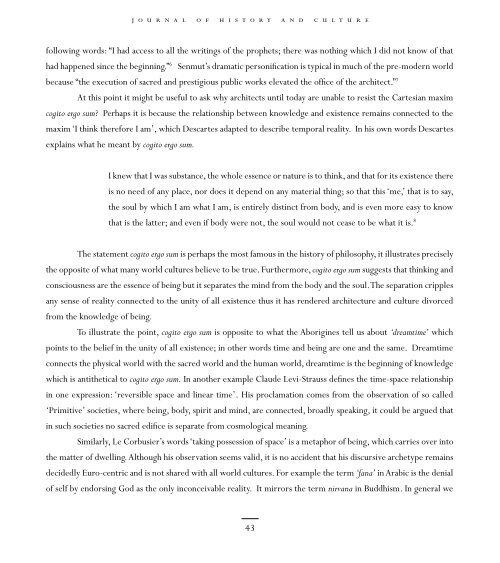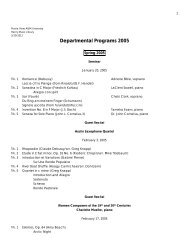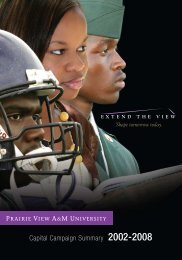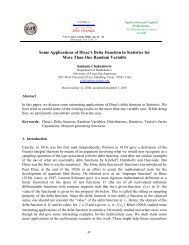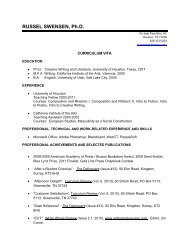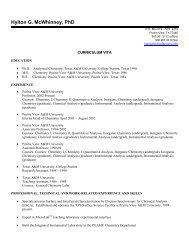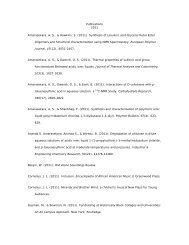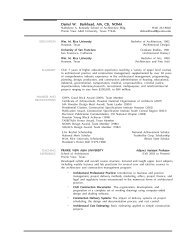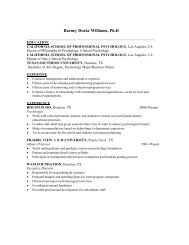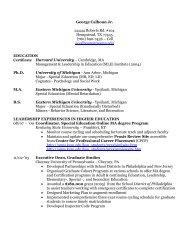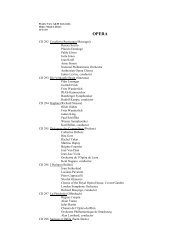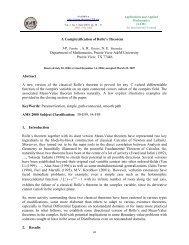Journal of History and Culture Journal of History and Culture
Journal of History and Culture Journal of History and Culture
Journal of History and Culture Journal of History and Culture
Create successful ePaper yourself
Turn your PDF publications into a flip-book with our unique Google optimized e-Paper software.
j o u r n a l o f h i s t o r y a n d c u l t u r e<br />
following words: “I had access to all the writings <strong>of</strong> the prophets; there was nothing which I did not know <strong>of</strong> that<br />
had happened since the beginning.” 6 Senmut’s dramatic personification is typical in much <strong>of</strong> the pre-modern world<br />
because “the execution <strong>of</strong> sacred <strong>and</strong> prestigious public works elevated the <strong>of</strong>fice <strong>of</strong> the architect.” 7<br />
At this point it might be useful to ask why architects until today are unable to resist the Cartesian maxim<br />
cogito ergo sum? Perhaps it is because the relationship between knowledge <strong>and</strong> existence remains connected to the<br />
maxim ‘I think therefore I am’, which Descartes adapted to describe temporal reality. In his own words Descartes<br />
explains what he meant by cogito ergo sum.<br />
I knew that I was substance, the whole essence or nature is to think, <strong>and</strong> that for its existence there<br />
is no need <strong>of</strong> any place, nor does it depend on any material thing; so that this ‘me,’ that is to say,<br />
the soul by which I am what I am, is entirely distinct from body, <strong>and</strong> is even more easy to know<br />
that is the latter; <strong>and</strong> even if body were not, the soul would not cease to be what it is. 8<br />
The statement cogito ergo sum is perhaps the most famous in the history <strong>of</strong> philosophy, it illustrates precisely<br />
the opposite <strong>of</strong> what many world cultures believe to be true. Furthermore, cogito ergo sum suggests that thinking <strong>and</strong><br />
consciousness are the essence <strong>of</strong> being but it separates the mind from the body <strong>and</strong> the soul. The separation cripples<br />
any sense <strong>of</strong> reality connected to the unity <strong>of</strong> all existence thus it has rendered architecture <strong>and</strong> culture divorced<br />
from the knowledge <strong>of</strong> being.<br />
To illustrate the point, cogito ergo sum is opposite to what the Aborigines tell us about ‘dreamtime’ which<br />
points to the belief in the unity <strong>of</strong> all existence; in other words time <strong>and</strong> being are one <strong>and</strong> the same. Dreamtime<br />
connects the physical world with the sacred world <strong>and</strong> the human world, dreamtime is the beginning <strong>of</strong> knowledge<br />
which is antithetical to cogito ergo sum. In another example Claude Levi-Strauss defines the time-space relationship<br />
in one expression: ‘reversible space <strong>and</strong> linear time’. His proclamation comes from the observation <strong>of</strong> so called<br />
‘Primitive’ societies, where being, body, spirit <strong>and</strong> mind, are connected, broadly speaking, it could be argued that<br />
in such societies no sacred edifice is separate from cosmological meaning.<br />
Similarly, Le Corbusier’s words ‘taking possession <strong>of</strong> space’ is a metaphor <strong>of</strong> being, which carries over into<br />
the matter <strong>of</strong> dwelling. Although his observation seems valid, it is no accident that his discursive archetype remains<br />
decidedly Euro-centric <strong>and</strong> is not shared with all world cultures. For example the term ‘fana’ in Arabic is the denial<br />
<strong>of</strong> self by endorsing God as the only inconceivable reality. It mirrors the term nirvana in Buddhism. In general we<br />
43


